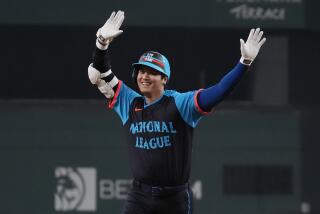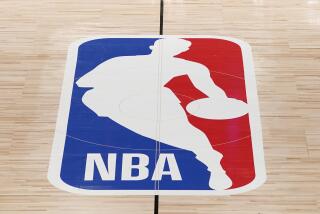What’s next after old ball returns?
- Share via
New Year’s celebrations might be louder than usual in NBA locker rooms today.
When the curtain closes on 2006, so does the brief run of the league’s new basketball. The new year brings the return of the old ball, the leather one players said never should have been replaced.
“Hallelujah,” Minnesota’s Kevin Garnett said.
Players criticized the performance of the microfiber composite ball from the moment training camps opened. The NBA stood by the product, but players’ complaints that it cut their skin followed by the filing of an unfair labor practice charge forced Commissioner David Stern to put the new balls back on the rack.
“It worked. I didn’t think it would,” Cleveland’s LeBron James said. “I can’t wait!”
But before James and his pals pat themselves on the back too much, here’s something they should keep in mind: There’s no guarantee their beloved leather ball is the one that will be tossed up to open the 2007-08 season.
“Not necessarily. It really depends on what the best product is for the game,” said Dan Touhey, vice president of marketing for Spalding. “We certainly feel based upon what every other league in the country is using and every other high school and college that the composite balls are here to stay, and they have reached pretty close to the highest level of competition.”
The stats show the ball had no real negative impact in the NBA. Scoring is up about 2 1/2 points per game from a similar point last season, and field-goal and free-throw percentages also have risen.
Although Stern said that things are now “open to what we start the season with,” he also said he wouldn’t set any “artificial deadlines.”
As much as players welcome the current change, the transition might not be as smooth as they expect. Besides the difference in the grip, leather takes time to break in, so the balls they handle next week might feel a bit different from what they remember.
“I haven’t seen the old ball for a long time. I mean, I haven’t played with it since the summer and last season,” said Wally Szczerbiak, whose Boston Celtics are the only team scheduled to play Dec. 31 and Jan. 1.
“So hopefully, they’ll get it in our hands, and we’re just going to have to adjust. It’s something they want to do, so we’re going to have to get a good warmup in before that game Jan. 1. It’s a transition no matter what you do, because it’s a different feel. I think everyone’s adjusted to this new ball. I certainly have, and it’s definitely going to be an adjustment period back.”
While the players and coaches worry about that, the NBA and Spalding are moving on to find the ball of the future. But this time they’ll have the players’ help.
Stern was criticized for changing the ball without first running it by the players. This time, the league already has reached out to players -- Garnett among them -- to see if they want to be part of the discussion.
What the NBA might find is that quite a few players prefer the new ball. International players are used to composite balls, which also are used at the amateur levels in the United States and will remain in play in the NBA’s Development League. Some rookies may never have used leather, so they might agree with Spalding and the league that synthetic is an improvement.
When the new balls are taken out of play, teams are being asked to hang onto about two dozen in case they’re needed for more testing. If another switch is in the plans, that decision must be made sometime early in 2007.
“The ultimate timing will be dictated by product development and the players,” Stern said.
Touhey said Spalding would need about four months to get all the new balls tested to make sure they were within specifications and shipped out to the teams.
Stern remains confident longtime partner Spalding will find something, leather or otherwise, that’s acceptable to the players. And there should be no complaints, because the players will help determine the next ball.
“At the end of the day it’s our responsibility to uphold the integrity of the game of basketball, and we have to do that in the right way,” Touhey said. “And that’s including the players in whatever process it takes to get the best ball for the NBA out there.”
More to Read
Go beyond the scoreboard
Get the latest on L.A.'s teams in the daily Sports Report newsletter.
You may occasionally receive promotional content from the Los Angeles Times.










